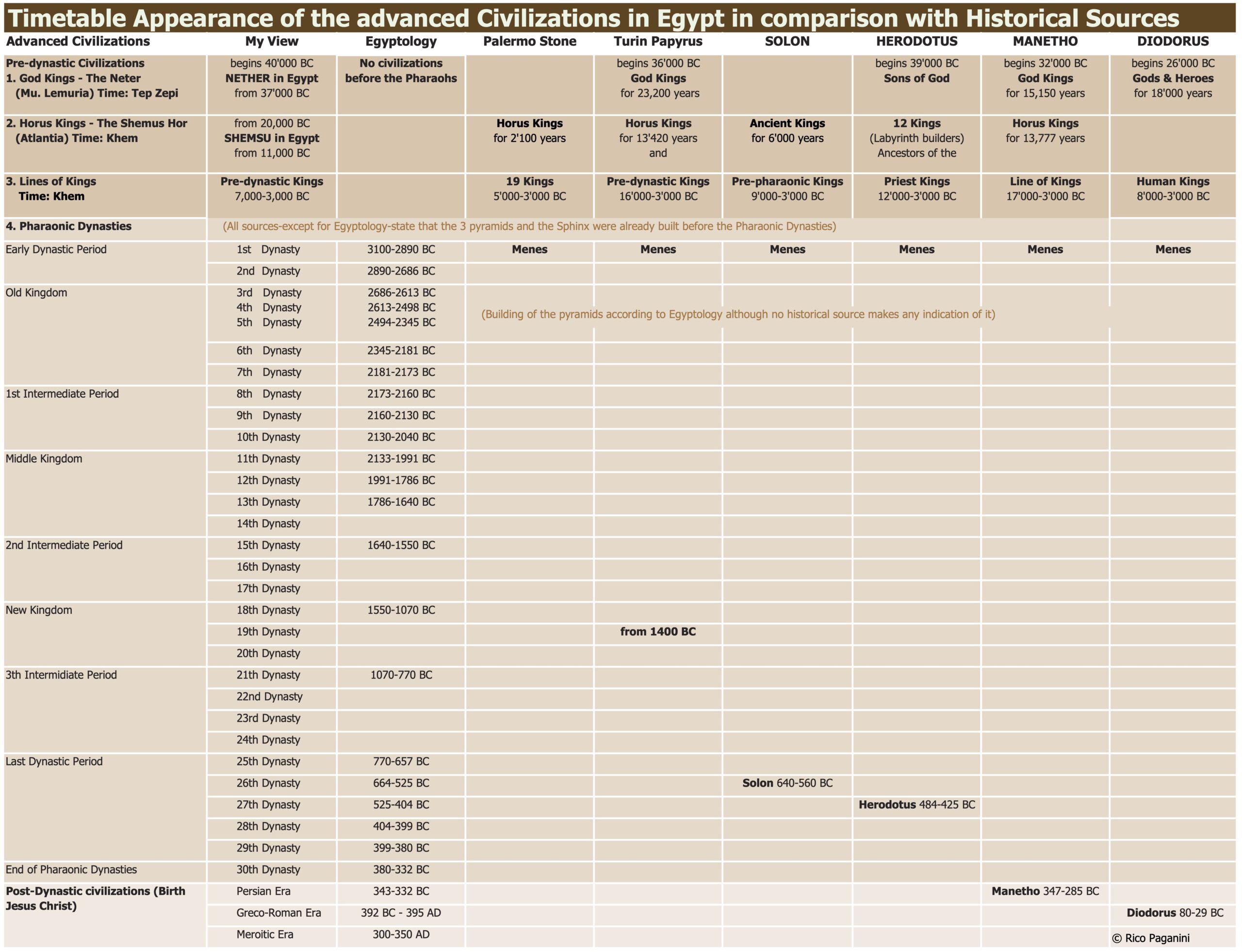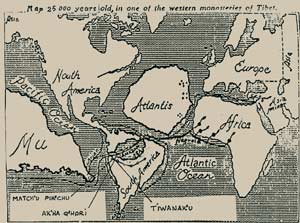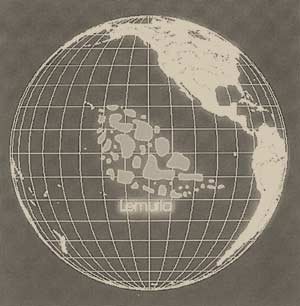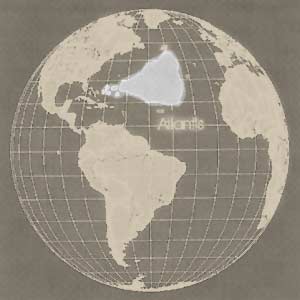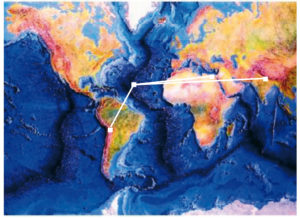Prehistorical History
Legendary Mu
Mu is a legendary continent that existed in what today is the Asian region of the Pacific Ocean, and which supposedly sank beneath the ocean in a manner similar to Atlantis. Others say that the name Mu stems from the middle syllable of Le-Mu-ria. The continent Mu was first mentioned by the British photographer and amateur archeologist, Augustus Le Plongeon (1826 to 1908), who conducted research about the Mayans. He claimed to have translated Mayan recordings that indicated that their civilization was founded by survivors of the demise of the continent Mu, and was older than either the Egyptians or the Atlanteans. Scientists today generally assert that these translations sprang from La Plongeons imagination.
Leading politicians of the day, especially in Asia, took an interest in the sunken continent. In the late nineteen thirties, the founder of contemporary nation of Turkey, Mustafa Kemal Ataturk, sponsored intensive studies about Mu. His objective was to study the parallels between the original culture of the Turkish peoples, the Ugrics and many Indian cultures as well as the Aztecs and Mayas in South America. Today, it seems most probable that the three prehistoric civilizations the Lemurians in the Pacific, the Atlantean in the Atlantic Ocean and the Muians in Asia transitioned into one another. Mu and Lemuria were probably situated in close proximity to one another both in terms of geography and time.
The History of Lemuria
The Lemurian civilization
Lemuria, once located in the region where today the Pacific Ocean exists, was supposedly three times larger than Atlantis. Australia, New Zealand, Madagascar and countless other islands in the Indian Ocean as well as French Polynesia, Fiji and Hawaii were all once part of this gigantic continent, of which only the peaks of the mountains jut out from the ocean today. The eastern coast of Lemuria stretched to the coast of California and beyond. Travels in Hawaii in September 2006 revealed that the traditional priests and healers, the Kahuna, taught that the Hawaiians originated from the Lemurians They have even retained knowledge of the connection to the pyramids in Giza.
The Lemurian civilization, according to legend, is the oldest Earth civilization, existing around 30,000 years before Christ, which would match the time period of the Indian Vedas. It is said that the Lemurians were far more sophisticated and spiritual than is commonly the case in our civilization, and lived in peace and harmony with the divine laws. Their bodies were not yet fully incarnated and are described as soft and gelatinous, though they assumed the same form as people today. According to the Vedas, the original beings were encased in a body, that was pliable, nearly spongy and somewhat translucent, and there were closely bound to the natural elements. So to speak, the spirit of human beings spawned the material body. This process of earthly incarnation, however, was not completed until the end of the third Atlantic Period.
Lemurians in Giza
The importance of Giza, according to historical tradition, such as that recorded on the Emerald Tablet of Thoth, goes further back than Atlantis. According to the legends, the Halls of Amenti that lie deep beneath the pyramids stood alone long before the age of the three Atlantean cycles. Supposedly, one of the Lemurian kings laid the founding stone in Giza at this special location to honor the ONE. For this reason, a large chamber was built in the ground using holy geometry the Flower of Life was placed at the center of this room and was ringed by seven thrones, which depending on which tale is being told, were dedicated either to seven Lemurian or seven Atlantean kings, or the seven archangels, or the seven Lords of Amenti (we favor the latter). It is also likely that the Lemurians cut the Cistern Chamber from the stone base of the Great Pyramid and thus determined the starting point for this massive complex, which in the day would have been exactly 30 degrees longitude and 30 degree latitude.
The decline
Legend says that the Lemurians, after living in peace for millennia, fell increasingly under attack from other life forms that came to the Earth, ultimately ending in one massive attack. To prevent a single one of them from falling victim in a hopeless war of defense, the Lemurian decided to retreat from the Earth, destroying their cities to prevent their occupation by their attackers. They accomplished the destruction of the planets surface with earthquakes and floods. The Lemurians acted wisely and reached safety before it was too late. In this way, nearly the entire race was saved from the dark beings, which departed after 1,000 years, driven away by illness and drought.
The History of Atlantis
Both the myth of Atlantis and the Great Flood, both appear in many significant historical texts, including the Vedas, the Gilgamesh Epic and the prehistory of the Egyptians, as well as in the Old Testament of the Bible, which once was the common holy book of Christianity, Islam and Judaism.
Introduction to Plato and Solon
The first historical mention of Atlantis in books was made by the great Greek philosopher Plato (see page 128), who greatly influenced the Western world view. Plato wrote his equally legendary and debated dialogue Timaios in 350 BC and later wrote Critias. In both these later works, the highly respected philosopher recorded what the Greek statesman Solon heard about Atlantis during his travels in Egypt.
“Timaios”
In his book, Timaios (21d-22a), Plato wrote about Solons visit to Egypt and the true occurrences that his compatriot experienced there. You are all young souls:
“For therein you possess not a single belief that is ancient and derived from old tradition, nor yet one science that is hoary with age. And this is the cause thereof: There have been, and there will be, many and diverse destructions of mankind, of which the greatest are by fire and water, and lesser ones by countless other means. For in truth, the story that is told in your country as well as ours, how once upon a time, Phaethon, son of Helios, yoked his fathers chariot and, because he was unable to drive it along the course taken by his father, burnt up all that was upon the earth, and himself perished by means of a thunderbolt that story, as it is told, seems like a legend, but the truth of it lies in the occurrence of a shift of the bodies in the heavens which move round the earth and a destruction of the things on the earth by fierce fire, which recurs at long intervals.”
In this legend we are again confronted with the question of whether Atlantis might have been destroyed by the collision of a space body with the Earth.
Following further explanations of the most ancient traditions kept and handed down by the Egyptians, the priest said to Solon:
“And the duration of our civilization as set down in our sacred writings is 8,000 years. The priest also told him that an Atlantean force moved from the Atlantic and spread throughout Europe and Asia. …there was an island before what you people call the Pillars of Hercules. The island was larger than Libya and Asia combined, and it provided passage to other islands for people who traveled in those days. From those islands one could then travel to the entire continent on the other side, which surrounds the sea beyond. Everything here inside the strait that we are speaking of, seems to be nothing more than a harbor with a narrow entrance, whereas there is really an ocean out there and the land that it surrounds all the way around truly deserves to be called a continent. On this Isle of Atlantis a great and marvelous royal power established itself and ruled not only the entire island, but many of the other islands and parts of the continent as well. Moreover, its rule extended even inside the strait, through Libya as far as Egypt and through Europe as far as Tyrrhenian. Then one day this power gathered into one force and set out to enslave all the territory inside the strait, including your region and ours, in one fell swoop. It was then, Solon, that your citys might shone bright with excellence and strength for all humankind to see. Sometime later, there were excessively violent earthquakes and floods, and after the onset of an unbearable day and night, your entire warrior force sank beneath the earth all at once, and the Isle of Atlantis likewise sank below the see and disappeared. That is how the ocean in that region has come to be even now to be unnavigatable and unexplorable, obstructed as it is by a layer of mud at a shallow depth, the residue of the island as it settled.”
“Critias”
In his late period dialogue, Critias, the Greek philosopher Plato addressed the Atlantis question in ever greater detail than in Timaios. That is why in ancient days, Platos book Critias was also called Atlanticus. Proklos wrote the following comment about Timaios: “So said Jupiter to them said Critias in Atlanticus, after he summoned the gathering of the Gods in order to punish the Atlanteans…”
Researchers of the works of Plato have been unable to clarify to this day, just when and by whom the expression Atlanticus was first used instead of Critias, however, it is apparent that this later work by the great philosopher focused on the history of Atlantis. In Critias he again wrote that the war and strife about which he learned from Solon, which had taken place 9,000 years previously and again described the location and size of Atlantis.
According to Plato, the descendents of Atlas ruled through many ages of man, cultivated lush vegetation and established a high civilization and in the process also learned some formidable technical skills. The crown was passed from the eldest son to the eldest son and each respective ruled reigned from the castle which Plato described in great detail. The council of ten kings laid down the law and no one was allowed to use violence. This peaceful civilization lasted thousands of years. For many generations, as long as the divine nature lasted in them, they were obedient to the laws, and well-affectionate towards the god, whose seed they were; for they possessed true and in every way great spirits, uniting gentleness with wisdom in the various chances of life, and in their intercourse with one another. They despised everything but virtue, caring little for their present state of life, and thinking lightly of the possession of gold and other property, which seemed only a burden to them; neither were they intoxicated by luxury; nor did wealth deprive them of their self-control; but they were sober, and saw clearly that all these goods are increased by virtue and friendship with one another, whereas by too great regard and respect for them, they are lost and friendship with them. By such reflections and by the continuance in them of a divine nature, the qualities which we have described grew and increased among them; but when the divine portion began to fade away, and became diluted too often and too much with the mortal admixture, and the human nature got the upper hand, they then, being unable to bear their fortune, behaved unseemly, and to him who had an eye to see grew visibly debased, for they were losing the fairest of their precious gifts; but to those who had no eyes to see the true happiness, they appeared glorious and blessed at the very time when they were full of avarice and unrighteous power.
Zeus, the god of gods, who rules according to law, and is able to see into such things, perceiving that an honorable race was in a woeful plight, and wanting to inflict punishment on them, that they might be chastened and improve, collected all the gods into their most holy habitation, which, being placed in the centre of the world, beholds all created things. And when he had called them together, he spoke as follows […] “Then Plato abruptly stopped the dialogue, believing that it was unseemly for mortals to learn more about the Council of the Gods. He had already described the results of this Council of the Gods in other writings, because the destruction of Atlantis could no longer be prevented.”
The Atlantean civilization
The Atlantic Empire was divided into twelve kingdoms, according to ancient Egyptian and Greek histories. It was supposedly a male-dominated society in which, however, great respect was held for women and feminine attributes. Goddesses were also honored in the magnificent temples of meditation. In contrast to the neighboring states to the east and west, monotheism held sway within the island empire. The Atlanteans lived for thousands of years inspired by a Resident, as peaceful servants of the Elohim.
The following passage from the book, The Emerald Tablets of Thoth, whom the Egyptians worshipped as a god who gave them knowledge and writing and papyrus and who was equivalent to the Greek god Hermes.
“In the late Atlantean period, Thotme was the father of Thoth and protector of the Great Temple, the link between the Children of Light who lived in the temple and the race of humans who inhabited the ten islands, the Voice of Horlet, the Dweller/Resident of Unal. The powerful Horlet, Lord of the Earth in the days of Atlantis, the earth-born King of the Nations, Master of Wisdom, Light Through Suntal, Guardian of the Path, he resided in his temple, the Master of Unal, the Light of the Earth in the Days of Atlantis. Know, oh ye human, that Horlet the Master was never one with the children of mankind. In times long past, when Atlantis first grew powerful, there appeared one with the Key of Wisdom who showed all the Path to the Light. He divided the kingdom into ten sectors that were ruled by the human children. Then he chose three who would become his access. He selected the three from the highest orders to be his connection to Atlantis. They became ambassadors who brought his counsel to the kings of the human children. He brought forth others and taught them wisdom so that they would become teachers for the children of men. He placed them on the island of Udal to stand as teachers of the light to humankind. […]
Keor was the city of the priesthood of Atlantis. On Undal, the island directly across from Unal, there were two cities, or more precisely, two parts of one large city that covered the island. The island was completely surrounded by terraced walls divided down the middle with a wall. Keor lay across from Unal and thereupon dwelled the priesthood, while on the other side of the island, known as Chien, resided the philosophical and scientific groups. Neither section could be entered unless one had a permit from the leaders. […]
There was light back then in ancient Atlantis, and yet darkness too lurked in all. Some who had risen to the highest heights among men fell from the light back into darkness as the big test approached. […]
They grew proud because of their wisdom and also proud of their position among men. The delved deep into the forbidden and opened the gateway that led to below; they sought to gain ever more knowledge, but attempted to bring it up from below. […]
But Horet in his temple saw all this. He saw how the Atlanteans had opened the gateway using their magic, which was to bring great suffering to the Earth. He called to him the three powerful Messengers and gave them orders that shook the world. The Resident descended down to the Halls of Amenti. There he summoned to him the powers that the seven Lords wielded; changed the worlds balance, and Atlantis sank down deep below the dark waves. The gateway that had been opened was destroyed, as was the gateway that led down below. All the island, except for Unal and part of the island of the Sons of the Resident, were destroyed. He spared them so that they would live to be teachers, lights on the Path for those how would come later, Lights for the lesser children of men. […]
He then called me, Thoth, to him and gave me instructions for all that I was to do, saying: Take thou, oh Thoth, all of your wisdom. Take all your records. Take all your magic. Go forth as a teacher of humankind. Go forth and preserve the records until such time as the Light again grows among men. Thou shalt be a light through all the ages, hidden, yet found by enlightened men. Gather now the sons of Atlantis and flee to the people of the rock caves. Flee to the land of the children of Khem. Then I gathered the sons of Atlantis and brought all my records from sunken Atlantis into the airship. I gathered all my powers and instruments of mighty magic. Then we rose upon the wings of the morning, high above the Temple, leaving behind the Three and the Resident deep in the Halls beneath the Temple. Beneath sank the Great Temple beneath the waves sealing the pathway to the Lords of the Cycles. Yet to those who know, the path to Amenti shall remain forever open. Quickly then we fled and flew to the land of the children of Khem. There by my power, I conquered and ruled them, raising the children of Khem to the Light. […]
Deep beneath the rocks I buried my airship, waiting for the time when man might again be free. Over the airship I erected a marker in the form of a lion, yet resembling humans. There, beneath this image, rests my airship still, to be brought forth with the need shall arise […] Know ye, O man, that in the distant future invaders shall again come from deep in space. The awake, ye who have wisdom, shall bring forth my ship and conquer them with ease. […]
My secret lies deep beneath the ground. Seek and find it in the pyramids that I have built. Each one is the keystone to the other; each is the gateway that leads into life. Follow the Key that I leave behind me. Seek and the gateway to Life shall be thine. Seek in my pyramid, deep in the passageway that ends in a wall. Use the Key of the Seven and the pathway shall open to you…”
Atlanteans in Giza
According to the ancient tales, the Atlanteans lived according to the role model of the Lemurians. There were three Atlantean cycles or three periods when civilization flourished in the Atlantic era. People there are said to have had mental skills including telepathy (which remained active among the Aborigines in Australia until the 20th century), telekinesis, teleportation and similar powers. This made them seem like gods to other cultures to the east and west of Atlantis. The Atlanteans were technically adept and built megalithic structures, such as the great pyramids in Giza. However, in the later period the people in Atlantis had begun to place their own wills above that of their kings, priests and even above the will of the gods, until, as happened before when Lemuria flourished, they were attacked from outer space.
As these attacks increased and a major invasion seemed to be upon them, the Atlanteans took action to retain the accomplishments of their culture and to pass them onto other peoples. They considered three locations to receive their inheritance which would also offer an explanation for why three advanced civilizations arose nearly simultaneously from seemingly nothing in South America, Egypt/Sumeria and India, in each case after a great flood. Giza, where the Lemurians had already built a chamber, was chosen by the Atlanteans as one of the three refuges as well as a storage location for their legacy. This is how Giza became a holy place containing the legacy of three great civilizations: from the Lemurians to the Atlanteans to the Sumerians and the Egyptian Pharaohs.
The decline
When it appeared that the major invasion was imminent, most kings and priests of the third Atlantis cycle believed that they should again act according to the role model provided by the Lemurians, which meant saving as many people as possible from violent death and a totalitarian civilization. However, several of the kings, many masters and even some dignitaries were convinced that they could ward off the danger this time using their power over the elements and natural forces. This eventually resulted in a split among the leadership and to disaster, simply because they could not bring themselves to abandon and destroy the wonderful cities, sites and temples that they loved.
However, this would have been the only way to ensure a positive outcome. Nevertheless, some of them preferred to least to attempt to ward off the attack, even though they had no experience with wars and battles. They thought that the worst that could possibly come of an attempt to defend themselves would be to destroy everything. And though in this they were also correct, they did not consider that things unforeseen might occur. Such considerations did prevent a portion the kings and high priest from fighting by all means, because they knew what could happen within gentle, wise people when they suddenly must conduct wars and ultimately destroy themselves.
In the latter days of Atlantis, when the anticipated attack began, a large portion of the Atlantean leadership and priesthood, even the highest leaders such as King Atlas and Tscheketet (Thoth the Egyptian) retreated with their followers and many Atlanteans. However, many high leaders and priests also took part in the attempts to battle back the dark invaders. This is when the great disaster occurred in which the energy system fell out of balance and could no longer be purposely used and ultimately went out of control. Some leaders grew angry at the Great King and Thoth, because they believed that had they assisted the defenders, then the disaster would not have happened. They had retreated in order to keep from falling into the hands of the invaders, after having discussed and decided to put up no further resistance because they believed it would only make matters worse. But many refused to listen to them and believed that they could win, even through part of their system had already broken down and the irregular attacks were growing ever stronger.
And finally their opponents began to use so-called weapon of wasting and the Atlanteans prepared to abandon their main cities after failing to beat back the invaders. Countless numbers of people then died because some of the defending leaders finally attempted to focus the three great Merkaba systems linked with the energies of the Source or Stone of Wisdom against the invaders. At first, it appeared to work and the invaders were pushed back, but then the masters lost control because the vibration of destruction split the stone and released unconceivable amounts of energy that afflicted the Earth so that the even the continents and oceans were reshaped.
Then the remaining leaders pleaded to the helpers of Elohim the Lord for support and in this way the world was saved from destruction. Actually, the intentions of the Atlanteans were good, even if their actions ended in a catastrophe on an unprecedented scale in which far too many people died. There must have been unbelievable tidal waves that swept the world. The sinking of Atlantic caused massive earthquakes which caused huge shifts of land masses. Even continental plates were broken and then the Atlantic continent sank and became the Atlantic ocean. The giant tidal waves meant that only those located high in the mountains managed to survive.
Despite, or even perhaps because of their overconfidence in their technology, the Atlanteans failed in their attempt to conduct warfare. Their attempt to defend themselves from the invasions from outer space went out of control. (Is very similar to the descriptions of contemporary reactors for the splitting of atoms or neutrons as well as the seapon of wasting – a coincidence?) Thus, Atlantis is also a key for our modern age and for understanding the contemporary technological society, as well as a key to understanding the Giza complex and the legacy that slumbers there. It also holds the key for understanding the other megalithic structures throughout the world, nearly all of which were built by the descendents of Atlantis in various epochs. One of the typical characteristics of an advanced civilization is that they consider themselves great, important and nearly omnipotent… before they break apart.
The descendents of the Atlanteans
One of the fundamental books about Atlantis was published in 1939 by the American architect and Mayan researcher Robert Stacy-Judd. He concentrated his research primarily on the Yucatan Peninsula in Mexico and on its remnants of an advanced culture, which extend far beyond the time period attributed to the Mayan culture. He published sketches that showed the geological and historical changes in Earth history since the early days of Atlantis.
He, too, confirms that relatively few Atlanteans survived the catastrophe: Those who did sought refuge in the three predetermined locations.
- The first line through the Sinai and the Land of Khem in present-day Egypt.
- The second line from Polynesia through Columbia and Peru to Mexico.
- The third line through Persia and India and on to Tibet and China.
In these 3 regions, 3 advanced civilizations emerged from nowhere, leaving behind inscriptionless pyramids and other megalithic structures.
The History of Giza
After this journey through the prehistoric history of earlier advanced civilizations and their descendants, we return to Giza. And so I would now like to summarize the builders, the construction stages and the building technique in Giza as follows:
• First, the Lemurians (in early history called the Nether or the God Kings) built a subterranean room in this special location on the 30th degree of longitude and latitude. With the construction of the Hall of Amenti, they laidthe founding stone of the megalithic complex.
• This complex was expanded by the Atlanteans (in early history called the Shemsu Hor or the Horus Kings) to include the Hall of Records and additional passageways and rooms. After that, they built the Sphinx and the 3 pyramids with sacred geometry and in perfect astronomical alignment. They also built underground megalithic complexes in other places, such as the “Osireion” in Abydos (see page 78) and the “Serapeum” and the “Persian shaft” in Saqqara (see page 79 ff.).
There are various theories on how the Atlanteans built these complexes out of nothing but gigantic blocks of stone.
Here I would now like to briefly summarize my conclusion, which also agrees with old sources and newest knowledge from quantum physics:
The Lemurians and Atlanteans were technical masters in architecture and possessed great knowledge about the 5 elements, their connections and the structure of material creation (what we call alchemy today). They were able to change the specific density and weight of matter – including rock – through vibrations and sounds.
The blocks of stone were placed in a soft and cuttable state, such as clay, and then restored to their original density, which explains the precision of the processing.
Then, the specific weight was reduced to a fraction in order to shift and perfectly place the blocks through levitation. After that, they were restored to their original vibration.
• The following lines of the Horus Kings added the 3 small pyramids next to the pyramid of “Mykerinos” and the pyramid of “Cheops”, external temples, enclosures and the stairways to the smaller pyramid and the middle pyramid. These additional buildings also represent an incredible achievement and confirm that the Horus Kings were still strongly connected with their ancestors and some knowledge had been preserved. At that time, the Nile extended like a lake to the foot of the temple complex on today’s Giza Plateau, and there was a landing stage for ships.
• According to my interpretation, some smaller temples (such as the temple that Cheops had built for his wife according to the stele found) and the cemeteries with the mastabas date from the Pharaonic period.
This is an excerpt from the book GIZA LEGACY.


